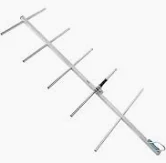UHF Yagi antennas are directional antennas renowned for their high gain and effectiveness in both receiving and transmitting UHF signals. Named after the Japanese inventor Hidetsugu Yagi, these antennas comprise several key components, including a driven element, reflectors, and directors. The driven element is essential, as it is where the feedline connects, allowing for the conversion of electrical energy into radio waves and vice versa. Reflectors and directors, which are positioned behind and in front of the driven element, respectively, play a crucial role in directing the signal, enhancing gain, and improving directivity.

One of the defining characteristics of UHF Yagi antennas is their length, which significantly affects signal reception and transmission. The physical dimensions of the antenna, including its elements, impact its performance characteristics, such as gain, bandwidth, and radiation pattern. As the frequency of operation increases, the length of each element must decrease proportionally to maintain resonance and optimal performance. This relationship between frequency and element length is fundamental to antenna design, influencing how well the antenna can capture or transmit signals effectively.

The length of a UHF Yagi antenna plays a critical role in its ability to pick up signals from specific directions while rejecting interference from other sources. A longer Yagi antenna generally offers higher gain, allowing for greater distance in signal transmission and reception—an essential factor in applications such as television broadcasting, amateur radio, and telecommunications. Conversely, a shorter antenna might struggle with efficiency and performance, leading to weaker and less reliable connections.
Understanding the construction and function of UHF Yagi antennas, alongside the importance of element length, provides a foundational perspective for exploring more advanced topics related to their design and application. As we delve deeper into this subject, we will further dissect the implications of antenna dimensions on overall system performance.
